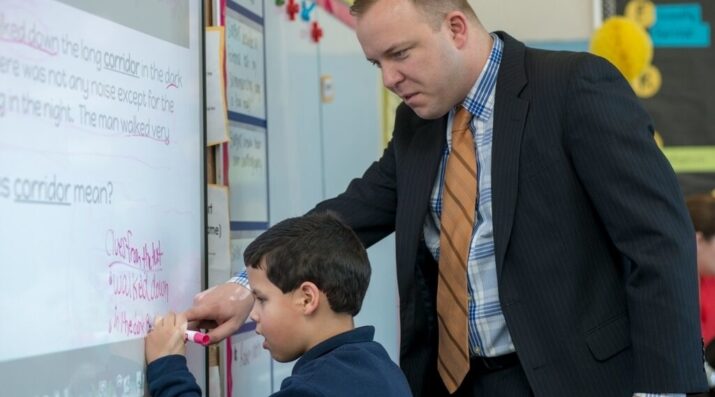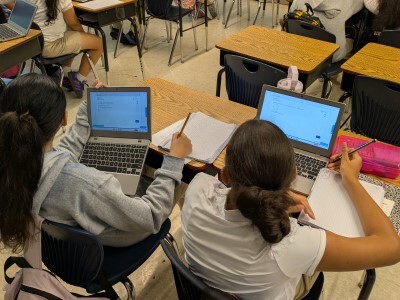5 Personalized Learning Practices in NGLC Grantee Schools
Topics

We’ve all had the experience of truly purposeful, authentic learning and know how valuable it is. Educators are taking the best of what we know about learning, student support, effective instruction, and interpersonal skill-building to completely reimagine schools so that students experience that kind of purposeful learning all day, every day.
Practitioner's Guide to Next Gen Learning
How do you know when a school is a personalized learning school? These five practices were described by the RAND Corporation in its research study of NGLC schools and we share additional resources related to each practice.
How do you know when a school is a personalized learning school? The RAND Corporation went about answering that question as part of Continued Progress: Promising Evidence on Personalized Learning, a report for the Gates Foundation that found positive achievement results in math and reading for students in schools using personalized learning strategies.
They focused on five personalized learning practices that are consistent with the Personalized Learning School Design Attributes:
- Learner profiles
- Personal learning paths
- Competency-based progression
- Flexible learning environments
- Emphasis on college and career readiness
They used a formalized research process drawing upon evidence from interviews, surveys, teacher logs, and school site visits to describe the practices used in 32 NGLC schools.
If you want to know more about the schools’ visions and individual model designs, see the NGLC publication Breakthrough Models for College Readiness: An Introduction to Next Generation Blended Schools.
If you want to learn more about the common practices and strategies used by the schools, read on.
Learner Profiles
RAND found that teachers in the NGLC schools had a variety of student data available to them to understand student progress and develop individual learning goals. This included achievement data, such as which students had achieved mastery and which students needed extra help. It also included data on student attitudes and behaviors. Teachers reported that they needed help translating data into instructional steps. But they typically accessed data from multiple sources frequently—at least weekly—and used it to inform their instructional decisions.
These resources provide more information about the use of learner profiles in NGLC schools:
- #NGLCchat on Learner Profiles and Personalized Learning Plans - This Storify summary includes links to resources, advice, and ideas from the NGLC community, including sample profiles (Update: Storify is no longer available)
- K-12 Roundup of Tools and Resources: Protocols and Processes in Personalized Learning Classrooms
- Next Gen Tools: Learner Profiles and Personalized Learning Plans - This publication documents how three NGLC schools incorporate these tools to personalize the learning experience and improve outcomes.
Personal Learning Paths
RAND found that three-quarters of schools implemented flexible or multiple paths through content. Instructional strategies to accomplish this included rotations through large-group instruction, small-group instruction, and independent work, often with the aid of technology. Flexibility and choice through academic content appeared to be teacher-driven more than student-driven. In other words, curriculum was aligned to local and state standards, and teaching staff customized learning activities for students around that curriculum. Older students often had more choice than younger students.
About one-third of schools use project-based learning as an opportunity for students to choose either the content or the end-product, or both. Project-based learning is the driving mechanism of the academic model in two NGLC schools.
All schools provide time for 1-on-1 academic support through tutoring, advising, and as-needed help during independent work time. This support is often triggered through the evaluation of student data.
Here are some additional resources related to personalized instruction in NGLC schools:
- Virtual Video Tours of Next Gen Learning Schools - See key components of personalized learning in action at four schools.
- Personalized Learning: Turning Lofty Aspirations Into Specific District Policy - An EdWeek webinar archive and presentation slides examining the core elements of personalized learning encompassing instruction tailored to student needs and the overall learning environment.
- 3 Personalized Learning Schools in Chicago - Describes the instructional practices observed when visiting three schools.
- Personalized Learning in Practice: Finding Exemplars of K-12 Customized Education - RAND reported what “is” at NGLC schools; this blog post looks at the “work in progress” to achieve the ideal state of flexibility, choice, and individualized support and pathway.
Competency-based Progression
All but two of the NGLC schools organize students and content by grade level, but “placement” in the content and a system of supports were often based on diagnostics of students’ learning level. Students could mostly move at their own pace through content, choosing how to spend their time, but there were often minimum expectations or classwide deadlines that students had to meet, and students might be afforded extra time outside of class to meet that expectation. Students advance through content when they achieve mastery in about two-thirds of schools.
Policy barriers and mandated standardized testing, including state end-of-course exams, are hampering a fully competency-based system of learning. NGLC schools are finding compromises to meet external requirements while supporting students’ learning needs. This is especially challenging to serve the many students in NGLC schools who are significantly below grade-level. As a result, competency-based progression was likely the hardest personalized learning practice to implement in NGLC schools.
More resources on competency-based progression practices in NGLC schools:
- (More) K-12 Tools & Resources: Competency-based Education - Resources from the Great Schools Partnership, whose coaches have supported the shift to proficiency-based learning in dozens of schools for the past decade.
- Personalized & Competency-Based Approaches Shape Learning in Two New Philadelphia High Schools - District high schools serving students many years below grade level.
- From “Shock and Awe” to Systemic Enabling: How New Hampshire is Charting the Nation’s Course for the Next Era of Education Reform - An example of a supportive educational climate for competency-based learning and other personalized learning practices.
- Building an Aligned System of Digital Content, Individualized Student Playlists, and Deeper Learning Assessments - Webinar archive and resources from Summit Public Schools describing the “orchestration” of student progress through a competency-based curriculum.
Flexible Learning Environments
RAND also looked at how NGLC schools used staff, space, and time in flexible and responsive ways. NGLC schools typically created flexible spaces within traditional classrooms using movable furniture and screens to fit instructional needs and student grouping strategies. A common strategy was grouping and regrouping—at least once a month—based on student needs in math and ELA classes.
Three-quarters of schools extended learning time with longer school days and longer school years. The time was mostly used for additional math and ELA instruction or 1-on-1 support/tutoring. Time was organized in longer blocks for teachers to vary their instructional strategies or to work on projects. Some schools used intercessions—two-week blocks for enrichment and experiential learning.
About a fifth of teachers reported “unconventional” roles, including co-teaching, job sharing, or supervision of another teacher. Non-credentialed instructional staff support students as tutors, instructional assistants, assistant teachers, and coaches. Some schools have dedicated staff responsible for students’ social-emotional development. The number of staff in a classroom was fluid, varying by lesson and needs.
Technology was another tool, “well-integrated into instruction,” used by schools to create a flexible environment. Digital content in math and ELA were most common. Tech was used by students to access curriculum materials, read, watch videos, use online references, and search for relevant materials online. Less frequent uses included using tech to solve problems, collaborate with other students, use adaptive software, and for simulations. Three-quarters of schools had 1-to-1 devices; two schools did not have devices available to all students.
Additional resources on flexible learning environments:
- How Flexible Learning Spaces Support Every Student - Architect Paul Klee describes key elements, benefits, and considerations of a flexible physical space that allows learning to be personalized and differentiated, dynamically adapting to the diverse needs and talents of each student.
- #NGLCchat: Schedules, Staffing and Space - On January 7, 2016 at 7pm ET, guest experts from NGLC schools e3 Civic High, Roots Elementary, Brooklyn LAB, West Generation Academy, and Match Next will share how they use these structures to support personalized learning. Join the chat by following the hashtag and using it in your own tweets.
- Next Gen Tools: e3 Civic High School Facility and Next Gen Tools: Blended Learning Classroom Design - These briefs describe the building and classroom designs two schools are using in ways that support, rather than inhibit, personalized learning practices.
- A Trip to the Windy City and Intrinsic Schools - A dive into the architectural design and staffing structures that support Intrinsic Schools’ academic model.
- What if Students Made a School? - Tom Carroll, president emeritus of the National Commission on Teaching and America’s Future, examines how students can take ownership of a school they help design, physically as well as culturally and academically.
Emphasis on College and Career Readiness
RAND looked at two aspects: developing non-academic skills like resilience and self-reliance, as well as college and career prep. All schools reported they incorporate additional college and career readiness skills beyond academics, mostly through an advisory curriculum and often via group projects and collaborative learning. Schools at all grade levels provided college and career prep establishing a college-going culture by talking about and providing information about college. High schools offered college counseling, college visits and some offered college credit experiences. Students in RAND focus groups said their school was “doing a good job of preparing them for life after high school.” Mostly, these strategies are similar to other college prep schools. One difference may be that students discussed a “curriculum that emphasizes self-direction” as a way their school helped to prepare them for their future.
More information about efforts in NGLC schools to prepare students for college and career:
- The Road to College & Career - This blog post and set of resources takes a look at how personalized learning schools help put students in the driver seat on the road to their own future.
- New Orleans Invests in College Readiness: A snapshot of student success in the nation’s largest K-12 charter market - How a city embraces college readiness, from school model designs to celebrating individual student successes as a community.
- Ahead of the Class: Earning College Credits Early and Promise and Challenge of the LPS Oakland College Launch Program - A look into how NGLC schools are providing early college experiences for students.
- Postsecondary Trending Now: Too Many Students Start College But Don’t Finish - How high school and college can create meaningful steps, with credentials, along the long and winding path from 9th grade to career; critical for students in poverty.




